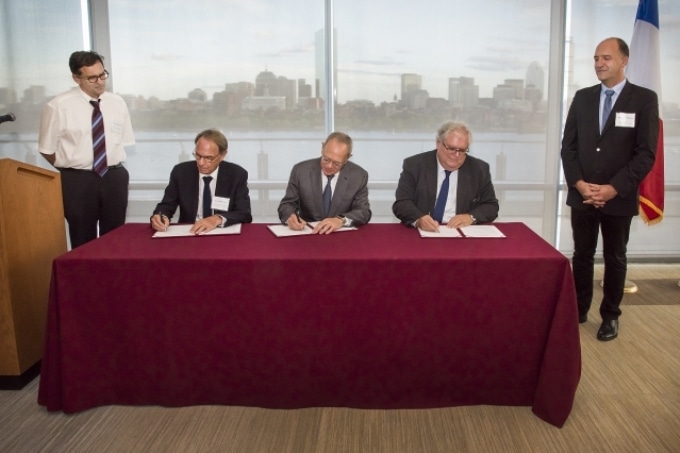Sep 13 2016
MIT President L. Rafael Reif joined a high-level delegation of French officials at MIT on Friday to sign an agreement extending the research partnership behind MultiScale Material Science for Energy and Environment (MSE2), an international joint unit, or UMI (reflecting the French term "unité mixte internationale"), that has produced groundbreaking research into such complex materials as concrete and shale rocks.
 Left to right: MIT Professor Franz-Josef Ulm, Aix-Marseille University President Yvon Berland, MIT President L. Rafael Reif, French National Center for Scientific Research (CNRS) President Alain Fuchs, and CNRS research director and MIT senior research scientist Roland Pellenq at a signing ceremony extending a partnership behind MultiScale Material Science for Energy and Environment (MSE2), which has produced groundbreaking research into such complex materials as concrete and shale rocks. Credit: L. Barry Hetherington
Left to right: MIT Professor Franz-Josef Ulm, Aix-Marseille University President Yvon Berland, MIT President L. Rafael Reif, French National Center for Scientific Research (CNRS) President Alain Fuchs, and CNRS research director and MIT senior research scientist Roland Pellenq at a signing ceremony extending a partnership behind MultiScale Material Science for Energy and Environment (MSE2), which has produced groundbreaking research into such complex materials as concrete and shale rocks. Credit: L. Barry Hetherington
Reif signed the agreement with Alain Fuchs, president of the French National Center for Scientific Research (CNRS), and Yvon Berland, president of Aix-Marseille University, extending the collaboration for another seven years. The new pact also formalizes Aix-Marseille University's role as a full partner in the UMI.
"At MIT, our mission directs us to bring knowledge to bear on today's challenges to make the world better. That's a big aspiration. That obviously goes well beyond the capacity of one institution or one nation," Reif said. "We take courage from knowing we face these challenges together."
Valéry Freland, France's consul general in Boston, and Minh-Hà Pham, counselor for science and technology at the French embassy in Washington, were among the approximately 50 people who attended the ceremony in MIT's Samberg Conference Center.
"Congratulations on this French-American success story!" said France's minister of state for higher education and research, Thierry Mandon, who spoke at the ceremony. Noting that France is working to bolster its higher education and research institutions, he said, "This is a perfect example of what we want to support."
More than 50 scholars work at the MSE2 lab, which hosts French researchers at MIT for years at a time. Going forward, MIT faculty and students will also have the opportunity to conduct research at a parallel lab centered at Aix-Marseille University: Centre Interdisciplinaire de Nanoscience de Marseille.
"We are privileged to have really top students from France here, and we're grateful Marseille is opening its doors to our students. We're delighted," said Bernd Widdig, director for international activities at MIT's Office of the Provost.
MSE2 was founded with support from the MIT Energy Initiative in 2012 to explore “bottom up” simulation and experimental verification of the properties of complex multiscale materials. Since that time, the joint lab has produced groundbreaking work — particularly in characterizing cement, the key component of concrete, the production of which accounts for 10 percent of carbon dioxide emissions worldwide.
"Because of its ubiquitousness, [concrete] has an enormous environmental impact," said Professor Franz-Josef Ulm, the George Macomber Professor of Civil and Environmental Engineering at MIT, who leads the lab along with Roland Pellenq, CNRS research director and an MIT senior research scientist, who emceed the day's events.
Ulm offered guests a brief summary of key MSE2 research, highlighting the lab's recent discovery that cement has the structure of glass — a finding that will enable engineers to apply the field of glass physics to concrete science and potentially reduce the environmental footprint of the material.
"UMI is driving progress in important areas of materials research," Reif said.
Speaking after the event, Pellenq said, "The UMI is the concrete expression of the will of merging engineering and science into a unified field where engineering solutions can be designed on sound fundamental scientific results. This is particularly important for complex materials such as concrete and shale rocks for which the span of complexity in texture and phenomena starts at the nanoscale. Altogether, this is an ambitious goal that encompasses education too; the UMI contributes to the annual Marseille Winterschool and the annual research workshop of the international network known as Groupement de Recherche International Multi-scale Materials Under the Nanoscope."
MIT's partner signatories also offered remarks at the ceremony. Fuchs of CNRS thanked MIT for its collaboration and noted that the partnership succeeds because it relies on excellence. "This is the way things should be made at the international level," he said.
Berland of Aix-Marseille University in turn highlighted the lab's interdisciplinary approach to multiscale research and noted that the UMI is successful because it integrates research with education and enlists resources from industry. "I am convinced that this project is an example to follow," he said.
Reif was similarly enthusiastic. "The UMI team has demonstrated a collaboration that is both strong and sustainable, and with today's signing we know it will be enduring as well," he said.